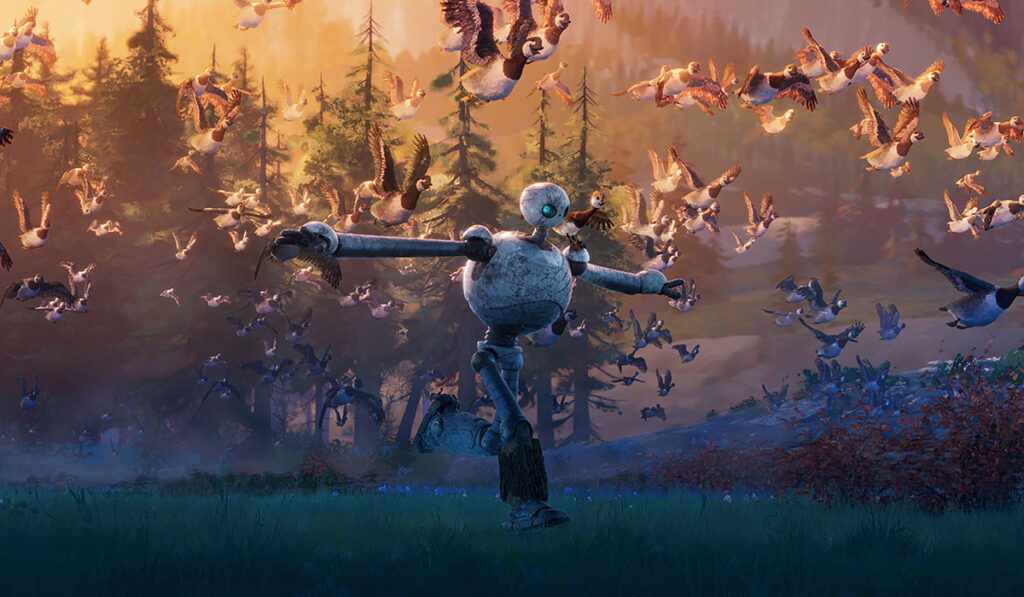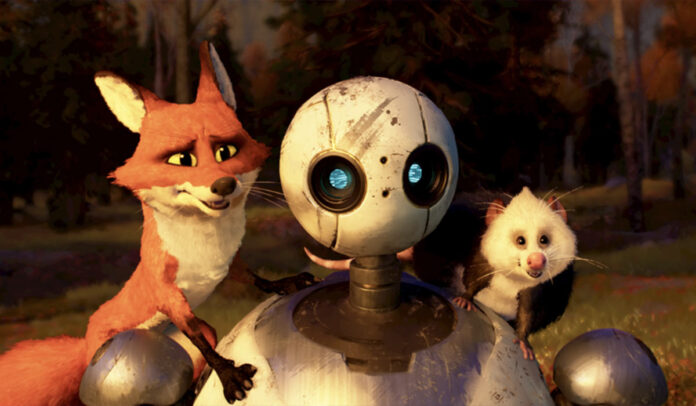It sort of goes without saying that Chris Sanders has been part of some incredible movies throughout his career. He earned story credit on animated classics “Beauty and the Beast” and “Aladdin.” He was a production designer on the original “The Lion King.” Alongside Dean DeBlois, he co-directed the Disney favorite “Lilo & Stich” and, arguably, the best DreamWorks Animation movie ever, “How To Train Your Dragon.” His first solo directorial effort, however, “The Wild Robot,” might mean the most to him.
READ MORE: “The Wild Robot” Lands with a tearjerker [Review]
Based on Peter Brown‘s popular literary series, “The Wild Robot” is still one of the most acclaimed films of the year and was a big hit for DWA and Universal Studios, considering its late September release date. Over the past few months, it has won Best Animated Feature (or Film) from multiple critics groups, snagged Golden Globe and Critics’ Choice Awards nominations, and led all films with 10 Annie Awards nominations. Moreover, it is a lock for an Animated Feature Oscar nomination and has an excellent shot at becoming the first DreamWorks Animated film to take the crown.
Recently, Sanders jumped on a Zoom to reflect on some of the inspired creative decisions he made for the movie. From his collaboration with composer Kris Bowers on the film’s key migration scene to finding the magic in Pedro Pascal, Lupita Nyong’o, and Kit Connor‘s performances to deciding between the current tearjerker ending and, yes, a potentially happier one.
This interview has been edited for length and clarity.
____
The Playlist: How many years of your life was it that you committed to making this film?
Chris Sanders: I think it was a little over three years, which is about the right amount of time, about three and a half. I think I started writing in 2020. I can’t really remember super clearly, but I think it was 2020 I believe.
And so when you put so much energy and effort for it, what is your reaction when people come out of your movie and they’re crying?
Oh God.
Does that emotional reaction make it all worth it?
It does. It matters a lot. I think that all of us fell in love with the story and loved the book. And making the film was like nothing I’ve ever experienced before. The crew just adopted this in a way I’ve never experienced. And so we all felt these things as I felt it as I was writing it and as Kris [Bowers] began adding his music. To see people react the way we felt when we made it is really, really, it’s the best thing ever. It’s the most rewarding thing ever. It does make it worthwhile.
I know how animated films work, I know things get pushed and pulled and taken out and redone. Do you remember the test screening or the friends and family screening where you realized, “Oh, this might actually achieve what we wanted?”
I remember the first time I saw our first finished working background with characters combined into it, and that was the first moment I was a little bit awestruck. And I’m allowed to be because I don’t do these things. I have my role, and I work the narrative, and I take this in certain directions, but to see what our artists achieved up on screen, I was stunned, and I thought, “I’ve never seen anything like this before.” The whole idea behind the look that I was going for was so that people would see the film the right way if that made sense. I knew kids were going to like this film, just every element in it is absolutely kid-friendly and would be very interesting to them. But I wanted adults to feel the same way that I felt as I read the book. So, getting a rather sophisticated design was critical, I felt, and it has really changed everything. People are reacting to the film in a way I’ve never experienced before, and it’s hard for me to put my finger on it, but it’s somewhere beyond what an animated film usually does. Because I’ve worked on some very successful films, films that were well received. So I understand that feeling, and it’s absolutely thrilling. But as people come out of this film and we talk, there’s a different thing going on. So, I do think people are seeing it differently. But again, somewhere between a live-action film and an animated film, it’s a little beyond, I think, what I’ve experienced before.
Any animated film is a gigantic team effort, but as the director, was there one image or anything that you had in your mind that was super important to you to incorporate into the film that maybe stuck with you while you were writing this script?
Absolutely. There’s this climactic moment at the midpoint of the film where Brighbill is going to fly away. I think a lot of times [it would be] the end of the film, but that’s our midpoint. The imagery connected to that was the most powerful that I started with. I saw this mass migration with Roz being a teeny tiny little part of it. The scale was part of what made it feel the way it feel felt, and just her being this little tiny part of it, but stuck in the ground. So, I wanted her to remain in this certain color space. It’s a cool morning with low-hanging mist, but as soon as the birds get only maybe 10 to 12 feet in the air, they touch this layer of light because the sun is just rising. And I thought that division was going to be emotional. Seeing it was a little bit like the reverse. It would be like putting a fish into water and seeing it swim away, and you can’t join it. So, in this case, it was bright Bill, and as he touches the light and all these birds touch the light, they’re officially leaving, and they’re peeling away from Roz. So, there was a method to the madness as far as the color was concerned. And so I saw that very early on.

Kris’s score is one of the most beautiful scores of any film I’ve heard this year. How did the conversations start with him coming up with it and when did you realize how special it was?
Yeah, Kris began work on the film very early, and he started sketching themes. And that particular moment in the film, it was one of the few times that I changed the score or asked for something a little bit different, I should say. And I had actually forgotten about this until Kris reminded me that his first version of that score, where Roz is saying goodbye to Brightbill, it was very sweet and sentimental, and I felt that it was a mix of more pain than that. I love that so often in an animated film, we can compose for joy. I don’t think that happens in movies very much, but in this case, it was bittersweet. So I actually asked Kris to take another run at that section of the film, just make it add maybe 20% more. I think pain and regret just to make it more complex. It’s a very complex moment because a lot of things are happening very quickly. And it’s one of the things I was excited about at that moment, the idea that these geese are leaving. To me, the image was equal to a train leaving a station, and you’re having a conversation with somebody you may never see again, and time has officially run out, so they’re going to have to be on that train. They can’t miss it. But now, suddenly, at the last moment, there’s way too much to talk about, and there isn’t time. And so the last thing that Brightbilll does is he says, “I can use a boost.’ And that’s what Kris titled the sequence, or that section was titled, “I Can Use a Boost,” because it’s the only thing that Brightbill can say to her to let her know that he’s sorry. And that’s the first time she realizes that his mindset has shifted from the day he confronted her.
She’s been stuck in the mindset that he’s done with her because that’s the way that Roz thinks. She’s got a different sort of architecture than you and I have. I think, to some degree, it would be fair to say she’s a bit neurodivergent. She has a very different way of thinking. And so when she is told by Brightbill we’re done, she takes that as an absolute. And she doesn’t realize that during this whole fight to get him into the air, he’s softening towards the whole thing because the pain is being leavened by time. So, at that moment, Roz is just like Brightbill. She had something laid on her at the last moment that’s too big for her to deal with, and she can’t do anything about it. So the only thing that she can do to express it is this final, very emotional burst of speed to just run to the edge of a cliff to see if she can see one last moment of him in the sky. And then, As I played this in my head over and over again, I thought, that’s not the end of the scene. The end of the scene should be as Longneck looks back and sees this being who he is very fond of, obviously in pain, that he’ll do something out of the ordinary. He’ll go off script, and he’s going to peel that one wing of the flight away and do a fly-by so that it’s a last chance for her to say goodbye and vice versa. But it’s all designed not to seal this whole thing off. We don’t want to heal it because this is our energy source. Going through the rest of the film is this unspoken thing that is not reconciled. Anyway, I’ve gone way too long on this answer, but what Chris did with that is absolutely stunning, and I’ve never heard anything quite like it. And that was another moment for me when he delivered that. We met once a week. I walked out of the studio, and I was just so stunned and so excited for people to see what I was seeing and to hear what I was hearing.



